
High up on the northern fen at an altitude of 1,841ft. (561m.) rises the river Tavy, first documented in 1125 as the Taui. The infant river trickles out of the peat at South Tavy Head and then makes its way down over a moorland course of about 5½ miles during which it tumbles down through ‘The Cleave’ and then winds it way on to Tavistock (meaning: stoc or holy place/monastery by the river Tavy) where it leaves the National Park to continue the final 14½ miles of it’s journey to the sea. During its journey from the head the river picks up no less than 19 tributaries which all swell its waters as they cascade over many rocks, falls and pools. The map below shows the majority of the Tavy’s moorland course as it winds its way down into the cleave.
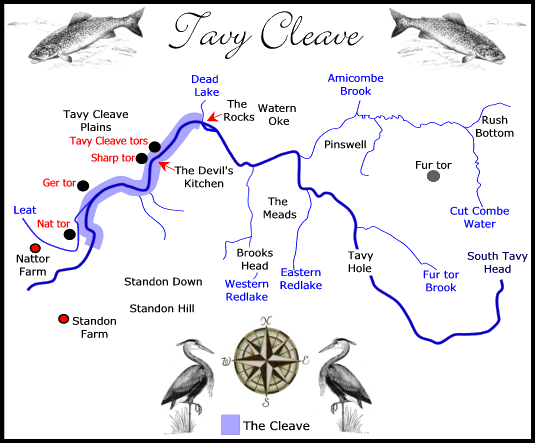
A cleave is basically a valley with steep, cliff-like sides, the word is said to derive from the Anglo Saxon word cleof meaning cliff. There are several examples of dramatic cleaves on Dartmoor, namely, Belstone Cleave, Lustleigh Cleave, Halstock Cleave, and Tavy Cleave. For centuries artists, poets, and authors have been drawn to the cleave for inspiration and to record its natural beauty. Below are just a few examples of works of art depicting Tavy Cleeve and as can be seen they all portray the wildness and ruggedness of the deep, granite lined valley. The other thing most of them have in common is the unrelenting weather conditions that can often be seen over the cleave with thick brooding clouds and swirling mists. Sadly, the thing they cannot portray is the sound of the river as it booms down over the many granite boulders sat in its bed. If you stand up on Ger tor when the river is in spate and peer down into the foaming, peat stained waters below the ferocity of the river is awesome.
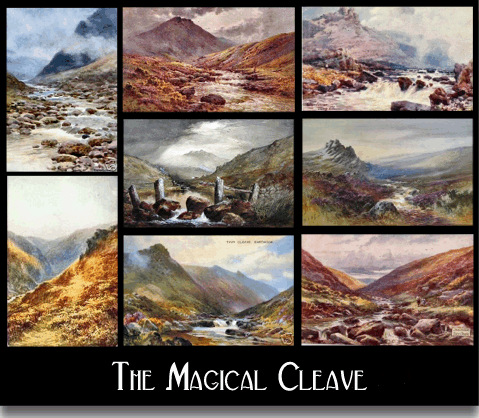
Having seen the somewhat prosaic and romantic paintings above it may be as well to take off the rose tinted spectacles of the artist and look at the stark truth. The photo’s below were taken in January 2006 and whilst there are some brooding cloud formations I would not call it that dramatic. Granted if you visit the cleave early on a bright summer’s morning or conversely a cold, snow covered afternoon it can be a magical landscape but day to day it’s nothing to write home about. But, having said that I am in the minority and most people sigh longingly when Tavy Cleave is mentioned and that must be the interesting individuality of ‘landscape’.
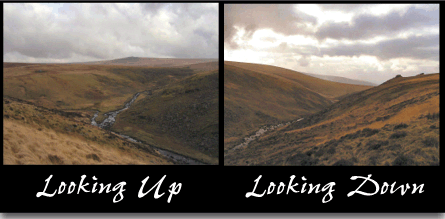
Probably on of the earliest written descriptions of Tavy Cleave comes from Mrs Bray when she says:
“The rocks above Tavy Cleave are not so much composed of the usual layers of granite as they are a conglomeration of small disjoined parts. Immediately below one of the walls (for such therefore we may call them) of the summit, the stones appear to have been thrown by the hand of Nature into a circular direction. Indeed, one might almost fancy them to have been ejected from the carter of a volcano as in a whirlwind and not to have lost their rotary motion on their descent. Most of them being on the edge, they look like petrified waves, and may be compared, perhaps, to the Mer de Glace, not however, in ice, but granite.”
Writing a few years later in 1848, Samuel Rowe gives his descriptive impression of the cleave:
“Still following the course of the Tavy downwards, we shall soon reach Tavy Cleave, a magnificent range of castellated tors with which nature appears to have fortified this fine peninsular hill, while the rapid stream sweeps round the headland and forms an effective moat to the Titanic citadel above. These tors range in succession along the precipitous sides of a rock-strewn declivity. There are five principle piles, of which the third is the loftiest and most majestic, and the whole cliff presents a remarkable resemblance to the dilapidated walls of a time-worn edifice. Even on a nearer approach, the illusion is kept up by the whortle, heath, and other plants flourishing in the interstices, so that the aspect of this mimic castle is novel and peculiar. Imagination, too, with little effort, may figure a natural outwork, or barbican, in the lower pile, on the southern glacis, guarding the approach, and thus fortifying this inland promontory almost to the river’s brink…,” p.219
Page then gives a remarkably similar description in 1898:
“A ramble down – or, still better, up – Tavy Cleave will disclose many beauties. The five tors which trend precipitously down to the brawling river are strewn with a profusion of clatters, concealed in many places by the heath and whortle-berry plants which grow thickly on the declivity. The rocky pinnacles above look almost like the ruins of castles constructed for the defence of this entrance to the moor,” pp. 105-5.
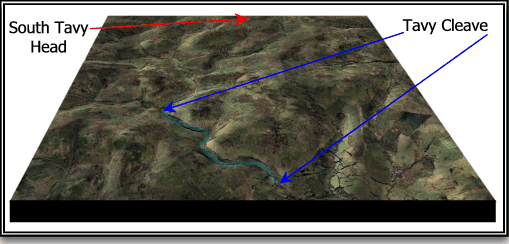
An aerial 3D topographical view of Tavy Cleave.
William Crossing devotes a whole chapter to Tavy Cleave but echoing the sentiments of the previous writers he adds:
“The beholder looks into the depths of the defile as from a precipice, and so far below is the Tavy that in appearance it can be likened to a rivulet. We have stood by these piles when the whortleberry gatherers were busy near the brink of the river; they looked like pigmies, and, but for their movements, could hardly be distinguished among the granite and the heather,” p.188.
There then appears to be some confusion, both Page and Rowe mention five tors and Crossing kindly sheds a bit of light onto them:
“The Group of tors to which allusion has already been made stands above the north-eastern side of the great amphitheatre, and consists of five distinct piles. These are usually known as the Tavy Cleave tors, only one of them bearing a distinct title. This the principle mass, the Moormen often call Sharp tor…,” p.188.
At the head of the cleave is a small island which stand in the middle of the river Tavy, this area where the Rattlebrook/Dead Lake joins the Tavy is known as ‘The Rocks’. The river then tumbles down through the cleave until it reaches ‘The Devil’s Kitchen’ which is a large pool that is fed by a seven foot drop above. With such a name one would expect that their was some satanic legend attached to it but sadly not, just a dangerous undercurrent for the unwary bather. From here the Tavy flows on down until it takes a sharp right hand bend before it goes beneath Ger tor, on top of which is a good view of the cleave. Then, after passing Nat tor the river meanders down in a more sedate fashion towards Tavistock.
As far as legend and folklore go, Tavy Cleave is associated with the story of Essara the Bard, and the tale of Tamara and Tavy, apart from that I am aware of little else. Oh, although not actually in the cleave, Lane End Farm was once a favourite spot to see the piskies. One other claim to fame for Tavy Cleave is that in the March of 1891 the cleave was filled with a giant snowdrift that was said to have been between 200 and 300ft
… Or gather and swell in Tavy Cleave
Where the stones cling Steep.
J. C. Squire
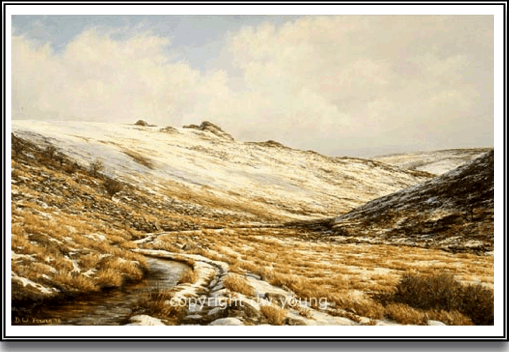
Winter Solstice – Tavy Cleave by kind permission of David Young
For more superb Dartmoor works of David visit his website – HERE
Reading List.
Crossing, W. 1987 Gems in a Granite Setting, Devon Books, Exeter.
Page, J. Ll. W. 1895 An Exploration of Dartmoor, Seeley & Co., London.
Rowe, S. 1985 A Perambulation of Dartmoor, Devon Books, Exeter.
 Legendary Dartmoor The many aspects past and present of Dartmoor
Legendary Dartmoor The many aspects past and present of Dartmoor
